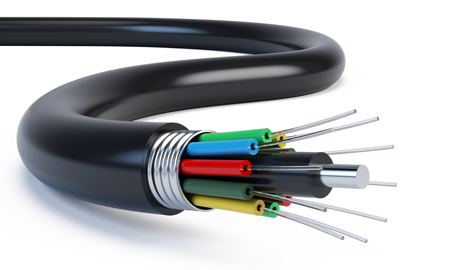Network connection to a remote device begins by considering the type of cable. In some cases, installed cable may already be present and available for reuse, or you may have the option to install a new cable. Let’s review the major types of cable used for most security applications, their advantages and disadvantages.
Types of cables
In general, there are four major types of cable. First is coaxial cable, which, given the many decades of analogue systems, has hundreds of thousands of existing connections. The second type includes Cat 5e and Cat 6, or what is commonly called Ethernet cable, the standard for network connections. The third is single pair cable, consisting of two wires and commonly used for alarm and access control applications. Finally, there is fibre, mostly used for long distances and outdoor applications.
Coaxial cable, given the many |
Cat 5e and 6 are used for networking connections. The cable consists of eight wires, commonly referred to as four pairs. Under the IP transmission and PoE standards, two pair, four wires, are used. Each of the sets are referred to as “A” or “B”. The standard requires that IP/PoE devices operate over either. Within the “A” or “B,” one pair is used for data while the second pair for PoE transmission.
Advantages of using multiple wires
The use of multiple wires has advantages for network transmission. Running cables in parallel reduces resistance to power transmission. Cable twists are standard in Cat cable. Twisting reduces noise as the twist cancels out noise-causing resistance. The size of the wire is also standard at what is known as 24 AWG.
The standardisation of Cat cable serves as the basis of IP transmission in determining its limit at 328 feet (100 metres). This also applies to resulting power delivered to a device powered by PoE. Starting with a source of 15.4 watts (802.3af- Class 3), after 328 feet, the resulting power is 12.95 watts. For 30 watts (802.3at-Class 4), the resulting power is 25.5 watts. Other than Cat cable, no other type of cable can be used for IP/PoE without the use of a media convertor.
The use of Cat cabling also allows transmitting PoE power higher than the current 802.3at source limit of 30 watts. Security camera manufacturers have developed video surveillance cameras with the ability to receive PoE on two wire pairs (rather than one pair) to what is in effect 802.3at. Given the highest voltage used for 30 watts which is 57 volts, up to 37 watts can be safely transmitted on a single pair and up to 74 watts using two pairs. This has given rise to the “60 watt PoE Cameras.” As two pairs are required, this application is restricted to Cat cables.
 |
| Fibre transmission method is the most extensive, requiring extra equipment for transmission and reception |
Power handling capacity
Keeping power in mind, one concludes that both coax and single pair will have much less power-handling capacity than Cat cable given that they are both single-pair transmission media. This means that both the signal and the power are carried over the same cable runs. There are several other important considerations for each.
Keeping power in mind, one |
With regard to coax: While Cat cable is used to set a fixed resistance yielding the resulting power and fixed bandwidth over 328 feet, 100 metres, coax has no such standards as applied to IP/PoE transmission. In general, taken over 1,000 feet, Cat 5e resistance is about 22-27 ohms. For coax to have similar results as Cat 5e, it would need the same resistance values. However, that isn’t the case. Coax resistance varies even within the same category of cable, such as the standard RG59. Differences in resistance will affect performance.
Noise rejection
Keep in mind that resistance Cat 5e cable also has standards with regard to the number and tightness of twists. These features affect noise cancellation within a cable. Single pair has no such standards and in fact can be found in flat wire configuration, which yields little or no noise rejection. Noise, in effect, is resistant to digital signals.
Finally, there is fibre. This transmission method is the most extensive, requiring extra equipment for transmission and reception. Its qualities include long transmission distance. Due to its glass structure, it is protected against lightning strikes and high power surges. The problem is, fibre doesn’t transmit PoE. Its use will require local power sources and power supplies. Fibre also has to be matched to be a completely matched system. The modems used must match the fibre, and there are several considerations based on single or multimode, and the transmission frequency.










































